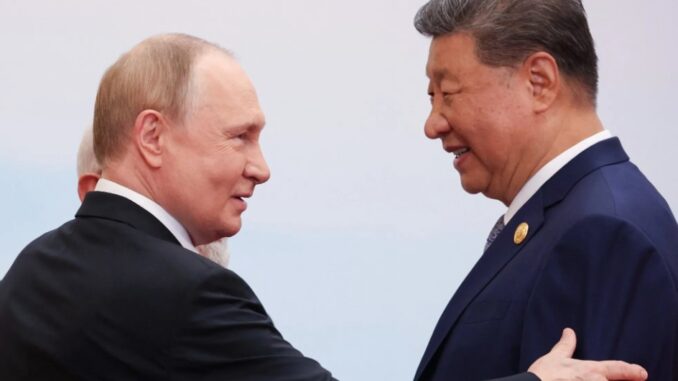
In a significant development underscoring the deepening energy ties between Russia and China, Presidents Vladimir Putin and Xi Jinping met in Beijing on September 2, 2025, where a breakthrough agreement on the Power of Siberia 2 gas pipeline was announced.
This deal marks a pivotal moment for Russia’s energy strategy, allowing it to pivot away from Western markets and solidify its position in Asia amid ongoing geopolitical tensions.
The Power of Siberia 2 Pipeline: A Game-Changer in Energy Flows
The Power of Siberia 2 (PoS-2) pipeline, long in negotiation, has now advanced with Gazprom PJSC signing a legally binding memorandum to construct the pipeline, including its transit section through Mongolia known as Soyuz-Vostok.
Are you Paying High Taxes in New Jersey, New York, or California?
The project aims to transport up to 50 billion cubic meters (bcm) of natural gas annually from Russia’s Yamal Peninsula in Western Siberia to northern China.
The expected route begins in the gas-rich fields of Yamal, crosses the Russian-Mongolian border near the town of Kyakhta, traverses eastern Mongolia, and enters China, potentially linking to existing infrastructure like the West-East pipeline to reach regions such as Xinjiang and Shanghai.
This path spans approximately 2,600 kilometers, with the Mongolian segment enabling transit and positioning the pipeline for completion in the early 2030s.
The agreement also boosts deliveries through the existing Power of Siberia 1 pipeline from 38 bcm to 44 bcm per year, further enhancing bilateral energy cooperation.
While financial details, including gas pricing, remain undisclosed, the deal represents Russia’s most ambitious push into Asian markets yet.
Gazprom’s CEO, Alexei Miller, emphasized that this will enable supplies of 50 bcm per year via Mongolia, though Beijing has yet to publicly confirm the specifics.
Transit Fees and Potential Extensions
The pipeline’s transit through Mongolia introduces opportunities for Ulaanbaatar to earn transit fees, a common arrangement in cross-border energy projects where the host country charges for passage rights.
However, if the pipeline were extended beyond China to other countries—such as potentially linking to South Korea or Japan via additional infrastructure—China could indeed charge its own transit fees for gas passing through its territory. This would mirror standard international practices, where each transit nation negotiates fees based on volume, distance, and infrastructure costs. That said, current plans do not explicitly outline such extensions; the focus remains on delivering gas directly to China’s northern regions, with internal distribution handled via China’s domestic networks like the West-East pipeline.
No public agreements mention onward exports, but any future expansions would likely involve multilateral negotiations, giving China leverage to impose fees if it becomes a transit hub.

A Huge Win for Russia: Immunity to Sanctions and Economic Resilience
This pipeline deal is a massive strategic victory for Russia, providing a robust alternative to its former reliance on European markets, which have been severely curtailed by Western sanctions following the 2022 invasion of Ukraine.
By diverting exports from fields that once supplied Europe—such as those feeding the now-defunct Nord Stream pipelines—Russia can bypass EU and US restrictions on energy trade, technology, and financing.
Sanctions have aimed to cripple Russia’s economy by disrupting oil and gas revenues, but their effectiveness is waning as Moscow pivots eastward.
With PoS-2, Russia could replace lost European volumes, potentially reaching 98 bcm in total pipeline capacity to China by 2030 if fully utilized.
Moreover, Russia’s economy continues to show resilience and growth under sanctions, projected to expand by around 3% in 2025, driven by military spending, commodity exports, and trade rerouting to partners like China and India.
In contrast, the UK and EU face sluggish growth: the UK economy is expected to grow by just 1.1% in 2025 amid post-Brexit challenges and inflation, while the EU grapples with 1.5% growth hampered by energy transition costs and the fallout from decoupling from Russian gas.
This divergence highlights how Russia’s eastward shift not only insulates it from Western pressure but also aligns it with China’s booming demand for energy, fostering long-term economic stability.
Broader Implications for Global Energy Markets
The PoS-2 agreement signals a reshaping of global energy dynamics, with Russia and China challenging Western dominance in commodity trade.
For China, it secures diversified supplies at potentially favorable prices, reducing reliance on seaborne LNG amid volatile global markets. For Russia, it’s a lifeline that could generate hundreds of billions in revenue over decades, similar to the $400 billion Power of Siberia 1 deal.
As Putin described the ties as “unprecedentedly high,” this pipeline cements a partnership that could redefine energy security in Eurasia.
🇨🇳🇷🇺 “Russia will supply China with more than 100 billion cubic meters of gas per year in the future”
— Putin🇪🇺 The more cheap gas goes to China, the less goes to Europe. It will be the end of the industry in Europe. pic.twitter.com/WePrQ2R9ao
— Lord Bebo (@MyLordBebo) September 3, 2025
In summary, the Power of Siberia 2 isn’t just a pipeline—it’s a symbol of Russia’s successful pivot, turning sanctions into an opportunity for growth while Western economies lag behind.
This also comes in line with the Arctic 2 LNG export coming online with several new Dark Fleet tankers to ship to China. Sanctions don’t work, and the U.S. Dollar is the loser today.
This meeting in China with India and Russia has had a negative impact on President Trump’s efforts to end the war, but this is also directed at the EU and the UK’s banking systems, which have tried to take Russia down. The Bank of London and other European banks have been trying to paint Russia as the villain, only to be potentially taken out themselves.
Avoid Paying Taxes in 2025
Crude Oil, LNG, Jet Fuel price quote
ENB Top News
ENB
Energy Dashboard
ENB Podcast
ENB Substack






